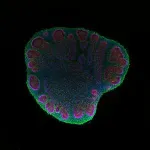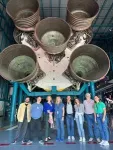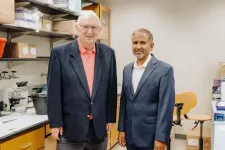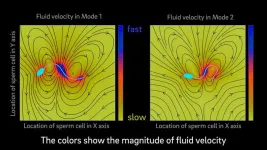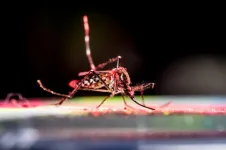(Press-News.org) City lights shine all night amid the bustling traffic, businesses and neighborhoods of Southern California, one of the most populated areas that mountain lions call home.
A study from the University of California, Davis, found that mountain lions avoid places with artificial light, even during the day. The finding adds to the list of challenges faced by the big cats in the region, where scientists have warned they may face extinction within decades.
The new study, published in the journal Philosophical Transactions of the Royal Society B, carries implications for the conservation of this sensitive species, and for wildlife crossing proposals. The authors described ways to limit light impacts in their design guidance for the Wallis Annenberg crossing over U.S. Highway 101, which broke ground in April 2022, and for a newly proposed wildlife crossing at Interstate 15 near Temecula.
“Well-lit streets, neighborhoods and commercial areas will reduce and fragment the areas available to mountain lions to move around,” said senior author Fraser Shilling, director of the UC Davis Road Ecology Center in the Institute of Transportation Studies. “It’s not just the outsized human footprint that is squashing lion habitat, but the extended glow from that footprint, too.”
Bright lights, big kitty
Large carnivores cover broad territories, which are increasingly compromised by roads, residential development and artificial light. The authors sought to unravel how artificial light at night and road proximity affect how mountain lions select their habitat in a heavily populated area like Southern California, where more than 20 million people live.
They used the locations of 102 radio-collared mountain lions, which were monitored in California between 2001 and 2022 by wildlife veterinarians with the UC Davis School of Veterinary Medicine, the California Department of Fish and Wildlife and other partners. They modeled the lions’ distribution relative to nearby artificial lights, developments, sky glow (diffuse light in the night sky from both natural and ground-based sources), and moonlight.
Illuminating factors
The study found that sky glow and moonlight did not influence the presence of mountain lions, but artificial light at night from nearby ground sources did.
“Overall, we found that mountain lions try to avoid zones lit artificially, possibly to avoid interactions with humans,” said lead author Rafael Barrientos, an ecologist with the Universidad Complutense in Madrid, Spain, and visiting scientist at the Road Ecology Center. “This can have cascading effects on the redistribution of the species in the region, as well as the benefits wildlife provide in this ecosystem.”
Previous studies by UC Davis and colleagues have shown that traffic-lion collisions and freeways that cut off Southern California mountain lions from potential mates have severely decreased their genetic diversity and threatened their existence.
“Our research has shown that even when structures exist to allow mountain lion passage under freeways, the light and noise can deter mountain lions from use of these safe crossing structures,” said mountain lion expert and co-author Winston Vickers, a wildlife veterinarian with the UC Davis School of Veterinary Medicine and its Karen C. Drayer Wildlife Health Center. “The findings in this analysis should increase the incentive for highway agencies to block light that spreads into the habitat from roads at crossing structures.
“On the positive side, the deterrent effect of light might be put to positive use to prevent livestock losses to mountain lions, and the subsequent killing of mountain lions in response.”
Funding for data collection was provided by CDFW Federal Aid and Wildlife Restoration Grants, California State Parks, The Nature Conservancy, San Diego County Association of Governments, the Orange County Natural Communities Coalition, and multiple foundations, nonprofits and private benefactors.
END
City and highway lights threaten mountain lion habitats
Artificial light a factor to consider for land-use and wildlife crossings
2023-11-06
ELSE PRESS RELEASES FROM THIS DATE:
Prostate cancer drug candidate developed at University of Tennessee Health Science Center goes to first clinical trial
2023-11-06
A drug candidate developed by researchers at the University of Tennessee Health Science Center for advanced metastatic castration-resistant prostate cancer is now in its first clinical trial.
Ramesh Narayanan, PhD, deputy director of the Center for Cancer Research and the Muirhead Endowed Professor in the College of Medicine at UTHSC, and Duane Miller, PhD, Professor Emeritus in the Department of Pharmaceutical Sciences at UTHSC, have worked for more than a decade on therapies involving the hormone receptors that influence cancer progression. Their drug candidate, a molecule designed as a treatment for ...
Model suggests that mammalian sperm cells have two modes of swimming
2023-11-06
A new mathematical model predicts that mammalian sperm cells have two distinct swimming modes. This prediction opens new questions about potential connections between sperm cells’ motor activity and their transitions to hyperactivation phases that may play an important role in fertilization. The finding is part of a larger effort to use math and fluid dynamics to describe how mammalian sperm move. The research is led by a team of engineers at the University of California San Diego. The new work is published in the journal Physical ...
Ochsner Health hospitals and partners earn national recognition from The Leapfrog Group
2023-11-06
NEW ORLEANS, La. – Several Ochsner Health hospitals and partners across the Gulf South have earned an ‘A’ Leapfrog Hospital Safety Grade for Fall 2023.The Leapfrog Group, a national nonprofit watchdog that sets standards for excellence in patient care, assigns a grade to general hospitals across the country based on more than 30 national performance measures reflecting errors, accidents, injuries and infections, as well as the systems hospitals have in place to prevent them.
The following Ochsner Health hospitals and partners received an ...
Neuromorphic computing will be great… if hardware can handle the workload
2023-11-06
Technology is edging closer and closer to the super-speed world of computing with artificial intelligence. But is the world equipped with the proper hardware to be able to handle the workload of new AI technological breakthroughs?
“The brain-inspired codes of the AI revolution are largely being run on conventional silicon computer architectures which were not designed for it,” explains Erica Carlson, 150th Anniversary Professor of Physics and Astronomy at Purdue University.
A joint effort between Physicists from Purdue University, University of California San Diego (USCD) and École ...
Lightening the load: Beckman researchers develop autonomous electrochemistry robot
2023-11-06
Researchers at the Beckman Institute for Advanced Science and Technology developed an automated laboratory robot to run complex electrochemical experiments and analyze data.
With affordability and accessibility in mind, the researchers collaboratively created a benchtop robot that rapidly performs electrochemistry. Aptly named the Electrolab, this instrument greatly reduces the effort and time needed for electrochemical studies by automating many basic and repetitive laboratory tasks.
The Electrolab can be used to explore energy storage materials and chemical reactions that promote the use of alternative ...
Success of Wolbachia-infected mosquitoes in fighting dengue may be underestimated
2023-11-06
The fight against dengue fever has a new weapon: a mosquito infected with the bacteria Wolbachia, which prevents the spread of the virus. These mosquitoes have now been deployed in several trials demonstrating their potential in preventing disease transmission.
Now, researchers at the University of Notre Dame have conducted an analysis of the World Mosquito Program’s randomized control trial of Wolbachia-infected mosquitoes in Indonesia, looking at how excluding transmission dynamics impacted the original interpretation of the trial’s results.
“Randomized controlled trials are the gold standard for evaluating the efficacy of any ...
The uncharted role of HER2 mutant alleles in breast cancer
2023-11-06
“Our research study has demonstrated that poziotinib is highly potent in neratinib-resistant HER2 L755S lobular and ductal breast cancer models [...].”
BUFFALO, NY- November 6, 2023 – A new editorial paper was published in Oncotarget's Volume 14 on October 31, 2023, entitled, “The uncharted role of HER2 mutant alleles in breast cancer.”
Somatic HER2 mutations are a novel class of therapeutic targets across different cancer types. Treatment with the tyrosine kinase inhibitor (TKI) neratinib ...
From basic research to application: NRL geophysicist awarded NDIA Undersea Warfare Bronze Medal Achievement in Science
2023-11-06
WASHINGTON – Warren Wood, Ph.D., U.S. Naval Research Laboratory Ocean Sciences Division’s Geology and Geophysics section head, received the National Defense Industrial Association (NDIA) Bronze Medal on Sept. 19, 2023 during a ceremony held at the Naval Submarine Base in Groton, Conn. for outstanding individual achievement in undersea warfare.
This award-winning work would not have been possible without fantastic teamwork, especially from the staff in Geology and Geophysics and Acoustic Simulation, Measurements & Tactics Branches,” said Wood. “Essentially a software ...
Study highlights optimal timing for assessing orthostatic hypotension in older adults and its impact on fall risk
2023-11-06
A new study, "Timing of Orthostatic Hypotension and its Relationship with Falls in Older Adults", has brought critical insights into the assessment of orthostatic hypotension, a drop in blood pressure commonly found among older adults when transitioning from a sitting or lying position to a standing position that can lead to dizziness and falls.
Published in the Journal of the American Geriatrics Society (JAGS) and based on a secondary analysis of the "Study to Understand Fall Reduction and Vitamin D in You (STURDY)," this study examined the prevalence of orthostatic hypotension at different time points after ...
RIT researcher looks for genetic switch to prevent ‘sleeping sickness’ in cattle
2023-11-06
As parasites adapt to a warming world, an infectious disease expert at Rochester Institute of Technology has his eye on the tsetse fly in sub-Saharan Africa. The biting fly transmits Trypanosomiasis, or “sleeping sickness,” to cattle there and could someday migrate to northern climates, including to the United States.
RIT researcher Bolaji Thomas is leading a $650,000 study funded by the U.S. Department of Agriculture, the National Institute of Food and Agriculture, and the Agriculture ...
LAST 30 PRESS RELEASES:
New expert guidance urges caution before surgery for patients with treatment-resistant constipation
Solar hydrogen can now be produced efficiently without the scarce metal platinum
Sleeping in on weekends may help boost teens’ mental health
Study: Teens use cellphones for an hour a day at school
After more than two years of war, Palestinian children are hungry, denied education and “like the living dead”
The untold story of life with Prader-Willi syndrome - according to the siblings who live it
How the parasite that ‘gave up sex’ found more hosts – and why its victory won’t last
When is it time to jump? The boiling frog problem of AI use in physics education
Twitter data reveals partisan divide in understanding why pollen season's getting worse
AI is quick but risky for updating old software
Revolutionizing biosecurity: new multi-omics framework to transform invasive species management
From ancient herb to modern medicine: new review unveils the multi-targeted healing potential of Borago officinalis
Building a global scientific community: Biological Diversity Journal announces dual recruitment of Editorial Board and Youth Editorial Board members
Microbes that break down antibiotics help protect ecosystems under drug pollution
Smart biochar that remembers pollutants offers a new way to clean water and recycle biomass
Rice genes matter more than domestication in shaping plant microbiomes
Ticking time bomb: Some farmers report as many as 70 tick encounters over a 6-month period
Turning garden and crop waste into plastics
Scientists discover ‘platypus galaxies’ in the early universe
Seeing thyroid cancer in a new light: when AI meets label-free imaging in the operating room
Neutrophil-to-lymphocyte ratio may aid risk stratification in depressive disorder
2026 Seismological Society of America Annual Meeting
AI-powered ECG analysis offers promising path for early detection of chronic obstructive pulmonary disease, says Mount Sinai researchers
GIMM uncovers flaws in lab-grown heart cells and paves the way for improved treatments
Cracking the evolutionary code of sleep
Medications could help the aging brain cope with surgery, memory impairment
Back pain linked to worse sleep years later in men over 65, according to study
CDC urges ‘shared decision-making’ on some childhood vaccines; many unclear about what that means
New research finds that an ‘equal treatment’ approach to economic opportunity advertising can backfire
Researchers create shape-shifting, self-navigating microparticles
[Press-News.org] City and highway lights threaten mountain lion habitatsArtificial light a factor to consider for land-use and wildlife crossings

